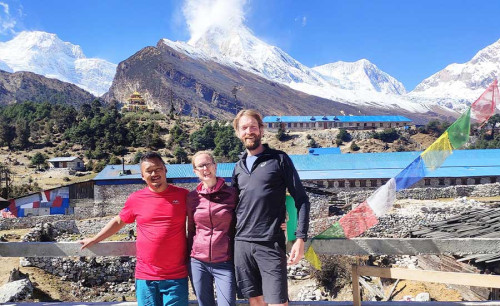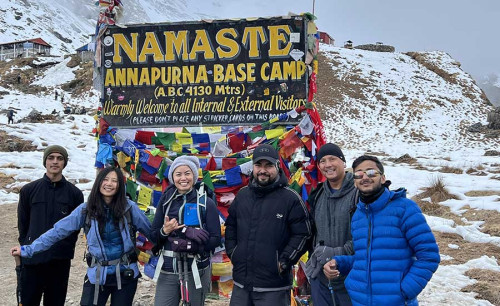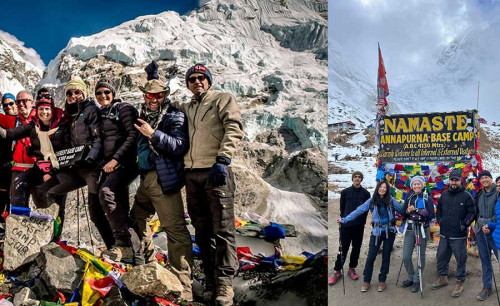Sherpas: The Heartbeat of Himalayan Expeditions
Published On : 28th May, 2024 By Himalayan Dream Team

Who are the Sherpas?
The Sherpas are an extraordinary group of around 150,000 mountain-dwelling people primarily residing in Nepal, Sikkim (India), and Tibet (China). Connected to the Bhutia, they also have smaller communities in North America, Australia, and Europe. Sherpas are of Tibetan culture and descent, speaking the Sherpa language, which closely relates to the Tibetan spoken in Tibet. While Sherpa is mainly spoken, it is sometimes written in Tibetan or Devanagari scripts. Most Sherpas in Nepal are bilingual, speaking both Nepali and their native Sherpa language. Those educated in Tibet or Tibetan Buddhist monasteries may also speak Tibetan. Additionally, many Sherpas involved in mountaineering can communicate in various languages of climbers and tourists.
Sherpas in Khumbu Region
Sherpas in Nepal predominantly live in the Solu-Khumbu district, a region within the Himalayas. This area is divided into two main regions connected by the Sun Kosi River: the Khumbu region, situated at elevations between 12,000 to 14,000 feet (3,700 to 4,300 meters) with higher pasturelands, and the Solu region, at elevations of 8,000 to 10,000 feet (2,400 to 3,100 meters). The Khumbu region extends from the Chinese (Tibetan) border in the east to the banks of the Bhotekosi River in the west.
The Origins and Culture of Sherpas
The name Sherpa, sometimes pronounced as Sharwa, means "easterner," referring to their origins in Khams, eastern Tibet. They began migrating in the 15th century and for centuries sustained themselves through trading (salt, wool, and rice), herding (yaks and cows), and farming (potatoes, barley, and buckwheat). Most Sherpas adhere to the ancient Nyingma sect of Tibetan Buddhism, blending it with animism. Sherpa society is organized into a clan system, with true Sherpa heritage determined through patrilineage. All Sherpas belong to one of 18 clans and carry a clan name.
Sherpas and Mountaineering
In contemporary times, the term "Sherpa" has come to refer to various ethnic groups in the region known for their exceptional mountaineering and trekking skills. These Sherpas, many of whom are ethnically Sherpa, have been indispensable in the ascents of numerous Himalayan peaks. Historically, despite their climbing abilities, Sherpas did not attempt to scale these mountains, viewing them as the abodes of the gods. Although mountaineering has since become a way of life, Sherpas maintain a deep respect for the mountains, striving to prevent foreign climbers from engaging in activities that could anger the gods, such as killing animals and burning garbage.
Sherpas: The Soul of the Everest Region
The Lifeline of Everest: The Sherpas
What makes any place thrive and come to life is surely its people. The Sherpas are the lifeline and soul of the Everest region. Westerners often recognize ‘Sherpa’ as a profession devoted to offering guided summits and tasked with the arduous porting of essential supplies from the base camp of Mount Everest. However, this perception is a simplification of a rich and vibrant culture.
Sherpas on Everest: More Than Guides
Sherpas, descending from Tibet, have been indigenous to the Everest region for more than 500 years. They mainly reside in the southern foothills of Everest, in the Solukhumbu district of Nepal. Sherpas also live in the surrounding valleys and villages and make up a significant portion of the urban population in Kathmandu. Known for their honesty, hard work, and sense of responsibility, Sherpas are a community deeply rooted in the mountains.
Sherpa Virtues: The Pillars of Mountain Life
The Sherpas embody virtues of honesty, hard work, and responsibility, which are essential for their life in the mountains. Their deep connection to the region and their cultural heritage make them indispensable to the thriving life of the Everest region.
Sherpas are not just guides and porters; they are the heartbeat of the Everest region, representing a unique blend of cultural heritage and unparalleled mountaineering expertise. Their contributions are fundamental to the spirit and success of expeditions in the majestic Himalayas.
Notable Sherpa Climbers
Notable Sherpa climbers include Ang Tharkay, the author of Mémoires d’un Sherpa (1954), and Ang Tsering (Tshering). Tenzing Norgay, famous for reaching the summit of Mount Everest in 1953 with Sir Edmund Hillary, was born in Tibet and was not an ethnic Sherpa. A remarkable female Sherpa, Pasang Lhamu Sherpa, reached the summit in 1993.
Trekking with the Himalayan Dream Team: Everest Base Camp, Everest Three Passes, and Luxury Options
The Himalayan Dream Team offers unparalleled trekking experiences, taking you to the heart of the Everest region. Here are some of the most sought-after treks, guided by the expert Sherpas:
Everest Base Camp Trek
The Everest Base Camp trek is a dream journey for many adventurers. This trek offers a chance to walk in the footsteps of legends, surrounded by the breathtaking beauty of the Himalayas. Guided by the expert Sherpas, trekkers will experience the unique culture, traditions, and hospitality of the Sherpa people while witnessing the awe-inspiring views of Mount Everest and its neighboring peaks.
Everest Three Passes Trek
For those seeking an even more challenging adventure, the Everest Three Passes trek is an exceptional choice. This trek covers three high passes – Kongma La, Cho La, and Renjo La – each offering spectacular panoramic views and a deep sense of accomplishment. Guided by experienced Sherpas, this trek allows adventurers to immerse themselves in the rugged beauty and cultural richness of the Everest region.
Premium Everest Trek for Adventurous Over 50s
Designed specifically for adventurous individuals over 50, this premium everest trek combines the classic Everest Base Camp experience with additional support and comfort. With the guidance of seasoned Sherpas, trekkers will enjoy a well-paced journey, ensuring safety and enjoyment throughout the trek.
Everest Base Camp Trek with Helicopter
For those looking to experience Everest Base Camp with a touch of luxury, this trek offers an unforgettable adventure. Trek to the base camp and then enjoy a breathtaking helicopter ride back, providing a unique perspective of the majestic Himalayas. Sherpas will guide you every step of the way, ensuring a seamless and enriching experience.
Luxury Everest Base Camp Trek
This trek is for those who desire the ultimate in comfort and style. Enjoy high-end accommodations, gourmet meals, and exceptional service as you trek to Everest Base Camp. The Sherpas, with their unparalleled knowledge and expertise, will ensure your journey is both luxurious and unforgettable.
Embark on a journey with the Himalayan Dream Team and let the Sherpas guide you through the heart of the Himalayas, where every step is a story and every peak is a triumph.
Recent Posts

24th Nov, 2025

21st Nov, 2025

10th Nov, 2025

9th Nov, 2025

25th Oct, 2025

22nd Oct, 2025

17th Oct, 2025

17th Oct, 2025

13th Oct, 2025

12th Oct, 2025





